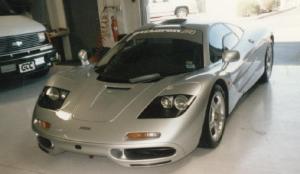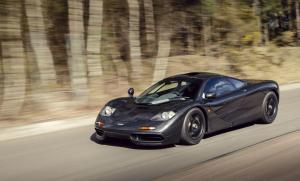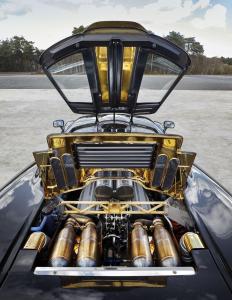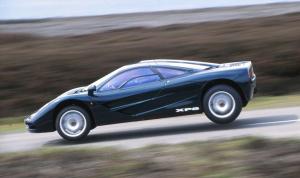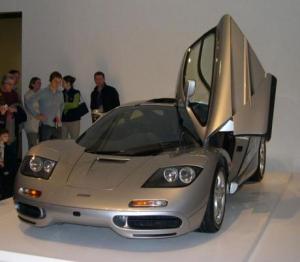









McLaren F1 specs
| Car type | Coupe |
| Curb weight | 1140-1288 kg (2513-2840 lbs) |
| Dimensions | 4.29 m (169 in) long, 1.82 m (72 in) wide, 1.14 m (45 in) high |
| Wheelbase | 2.72 m (107 in) |
| Introduced | 1993 |
| Origin country | United Kingdom |
| Gas mileage | 20.4 l/100 km (12 mpg US / 14 mpg UK) |
| Views | 160.7k |
Lap times
| Track | Time |
|---|---|
| Bedford Autodrome West Circuit (2004 - 06/2008) | 1:21.20 |
| Estoril | 1:55.90 |
| Tsukuba | 1:04.62 |
| Nürburgring Nordschleife | 7:18.00 est |
| Laguna Seca (post 1988) | 1:32.00 est |
| Hockenheim Short | 1:07.00 est |
| Sachsenring | 1:30.00 est |
Acceleration (kph)
| 0 - 40 kph | 1.5 s |
| 0 - 50 kph | 1.8 s |
| 0 - 60 kph | 2.1 s |
| 0 - 80 kph | 2.7 s |
| 0 - 100 kph | 3.2 s |
| 0 - 120 kph | 4.3 s |
| 0 - 140 kph | 5.1 s |
| 0 - 160 kph | 6.3 s |
| 0 - 180 kph | 7.3 s |
| 0 - 200 kph | 8.8 s |
| 0 - 220 kph | 10.1 s |
| 0 - 240 kph | 12.2 s |
| 0 - 260 kph | 14.1 s |
| 0 - 280 kph | 16.9 s |
| 0 - 300 kph | 20.3 s |
| 100 m | 5.0 s @ 139.0 kph |
| 1000 m | 19.0 s @ 292.0 kph |
| Est. 100 - 140 kph | 1.7 s |
| Est. 100 - 200 kph | 5.7 s |
| Est. 200 - 300 kph | 12.1 s |
Acceleration (mph)
| 0 - 30 mph | 1.7 s |
| 0 - 40 mph | 2.3 s |
| 0 - 50 mph | 2.9 s |
| 0 - 60 mph | 3.2 s |
| 0 - 70 mph | 3.9 s |
| 0 - 80 mph | 4.5 s |
| 0 - 90 mph | 5.6 s |
| 0 - 100 mph | 6.3 s |
| 0 - 110 mph | 7.2 s |
| 0 - 120 mph | 9.2 s |
| 0 - 130 mph | 10.4 s |
| 0 - 140 mph | 11.2 s |
| 0 - 150 mph | 12.8 s |
| 0 - 160 mph | 14.6 s |
| 0 - 170 mph | 17.2 s |
| 0 - 180 mph | 20.3 s |
| 0 - 200 mph | 28.0 s |
| Est. 1/8 mile | 7.5 s @ 110.6 mph |
| 1/4 mile | 10.8 s @ 142.3 mph |
| Est. 1/2 mile | 17.2 s @ 173.4 mph |
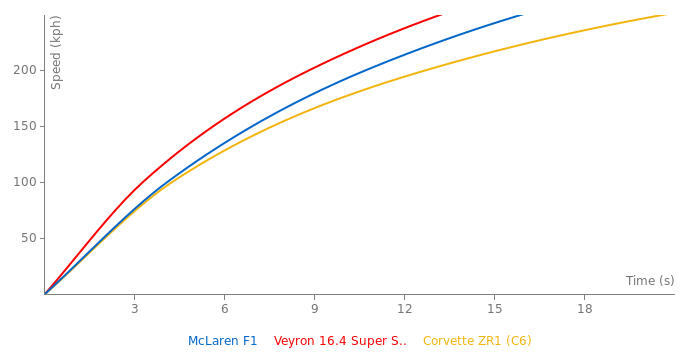
General performance
| Top speed | 391 kph (243 mph) |
| Est. max acceleration | 0.87 g (8 m/s²) |
| Lateral acceleration | 0.86 g (8 m/s²) |
| 60 mph - 0 | 39 m (127 ft) |
| 70 mph - 0 | 49 m (162 ft) |
| Noise @ idle | 66 dB |
| Noise @ 50 mph | 76 dB |
| Noise @ 70 mph | 78 dB |
Powertrain specs
| Engine type | BMW V12 |
| Displacement | 6.1 l (372 ci) |
| Power | 627 ps (618 bhp / 461 kw) |
| Torque | 647 Nm (477 lb-ft) |
| Power / liter | 103 ps (101 hp) |
| Power / weight | 523 ps (516 bhp) / t |
| Torque / weight | 540 Nm (398 lb-ft) / t |
| Efficiency | 31 PS per l/100 km |
| Transmission | 6 speed |
| Layout | middle engine, rear wheel drive |
F1 competition
Race 2m ago
The actual curb weight of any F1 is around 1250 kg, every car that is serviced at Woking is put on the scales.
wallenieswiftie 8m ago
Until the 750S (in the case of supercars) and the W1 (in the case of hypercars), this one was the only McLaren-badged vehicle to ever offer a limited-slip differential.
wallenieswiftie 8m ago
McLaren F1
Nürburgring Nordschleife Testing:Michelin Tires:
- Full layout: 7:18.66 (driver mod took major effort into the test)
- Shortened layout (4.73s rollout): 7:13.93
Goodyear Tires:
- Full layout (driver error): 8:45.54
- Shortened layout (8.33s rollout): 8:37.21
- Estimated clean lap (full layout): 7:34.84 + driver mod
Michelin Tires:
- 0-100 km/h (0-60 mph): 2.7s
- 0-160 km/h (0-100 mph): 5.8s
- 0-200 km/h (0-125 mph): 8.1s
- 0-400 m (1/4-mile): 10.18s @ 224 km/h (standing start); 9.58s (long rollout)
Goodyear Tires:
- 0-100 km/h (0-60 mph): 2.8s
- 0-160 km/h (0-100 mph): 5.8s
- 0-200 km/h (0-125 mph): 8.0s
- 0-400 m (1/4-mile): 10.38s @ 231 km/h (standing start); 9.57s (long rollout)
Michelin Tires:
- 0-100 km/h (0-60 mph): 3.2s
- 0-160 km/h (0-100 mph): 6.3s
- 0-200 km/h (0-125 mph): 8.6s
- 0-240 km/h (0-150 mph): 11.8s
- 0-300 km/h (0-185 mph): 19.4s
- 0-320 km/h (0-200 mph): 23.4s
- 0-400 m (1/4-mile): 10.90s @ 225 km/h
- 0-1000 m (3/5-mile): 18.75s @ 295 km/h
- Top speed: 375 km/h (233 mph)
Goodyear Tires:
- 0-100 km/h (0-60 mph): 3.9s
- 0-160 km/h (0-100 mph): 6.7s
- 0-200 km/h (0-125 mph): 8.9s
- 0-240 km/h (0-150 mph): 11.9s
- 0-300 km/h (0-185 mph): 18.9s
- 0-320 km/h (0-200 mph): 22.8s
- 0-400 m (1/4-mile): 11.41s @ 231 km/h
- 0-1000 m (3/5-mile): 19.11 @ 301 km/h
- Top speed: 367 km/h (228 mph)
To compare:
McLaren F1 vs. Ferrari F80, LaFerrari, Enzo, F50, F40, 288 GTO
Nring: 7:18.66 (6:35.10, 7:11.56, 7:36.28, 8:07.19, 8:28.35, 8:48.86)
0-100: 3.2 (3.2, 3.2, 4.3, 4.1, 5.0, 4.8)
0-160: 6.0 (4.9, 6.2, 7.2, 8.1, 8.2, 8.7)
0-200: 8.2 (6.4, 8.6, 10.0, 12.0, 13.3, 13.0)
0-240: 11.2 (8.5, 11.9, 14.0, 17.7, 17.8, 19.5)
0-300: 18.2 (16.1, 20.4, 25.7, 45.7, 29.4, 43.1)
400-1000m delta: 7.70 (7.18, 7.72, 8.07, 8.86, 8.75, 9.31)
wallenieswiftie 8m ago
https://imgur.com/gallery/how-is-mclaren-f1-build-automation-game-1OBKD9Q
How is my McLaren F1 build?
wallenieswiftie 1y ago
Nurburgring Nordschleife lap time: 8:06.28 at the 20.8-kilometer variant of this track, this time with a more realistic supercar body + some interior work resembling the McLaren F1.
+600kg constant downforce (33% front : 67% rear)
75% braking power (front and rear)
Remember, this was the '90s. Cars didn't feature as much tire and braking technology back then.
Lap starts at 3:21.
wallenieswiftie 1y ago
MY BEST AND FINAL LAP TIME AT THE NURBURGRING NORDSCHLEIFE with the McLaren F1: 8:01.20 (very comparable to the real-life results of the Bugatti EB110 SS and Lamborghini Diablo GT)
koenigseggjesko 1y ago
This car is the most popular car on FastestLaps.com; its even more popular than the AMG ONE.
RickyAstle98 1y ago
For those who still thinking about 20.3 seconds to 300KPH
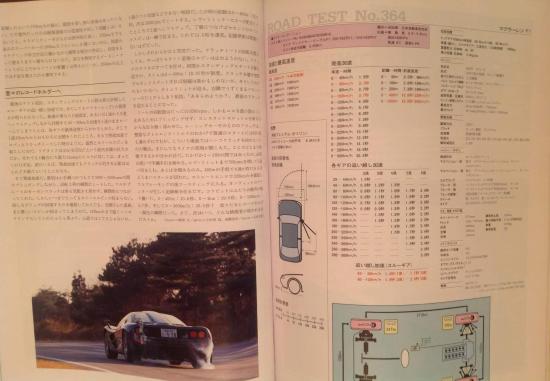
The acceleration testing session was done w/passenger w/6mph tailwinds and propably half fuel tank, Japanese loves doing that! Just think about, how cold air and 3% downhill can make a difference for 600HP/1200KG car?
Japanese logic > minus 0.3 to higher numbers as rollout (compensation)
300-320kph@4.6s
0-300kph@20.6s
0-320kph@25.2s
300-320kph @ 4.6s
VOILA
Crispi74 1y ago
French Sport Auto tested the same F1 that was tested by CarGraphic:
0-100 kph 3.3s
400m 11.1s
1000m 19.6s
100-140 kph 5th gear 3.3s
100-140 kph 6th gear 4.5s
Top speed 371 kph (factory data)
Weight checked 1263 kgs
the car seems slower than when tested the day by CG.
0-100 kph 3.7s
400m 10.8s
1000m 19.0s
100-140 kph 5th gear 3.2s
100-140 kph 6th gear 4.8s
ian 1y ago
my dream car has always been the McLaren F1GTR. i have devoted over 10 years to researching the stats of this car. this website is by far the best helper to me.

Thiago_Lins 2y ago
A question arose: were the McLaren XP5 and F1 different?
The performance figures obtained in tests with the XP5 chassis are much better than those presented by the "normal" F1.
McLaren F1 XP5, Car and Driver, 1994 (Autocar & Motor)
0-60 mph 3.2s
0-100 mph 6.3s
0-120 mph 9.2s
1/4-Mile 11.1s @ 138 mph
McLaren F1, Road & Track, 1997:
0-60 mph 3.4s
0-100 mph 7.7s
0-120 mph 10.5s (+1.3s) 😐
1/4-Mile 11.6s @ 125 mph (-13 mph) 🙃
The difference appears to be because of a much stronger spec (XP5). Would changing from a European to an American version hurt performance that much?
(sorry for my English) 👍







